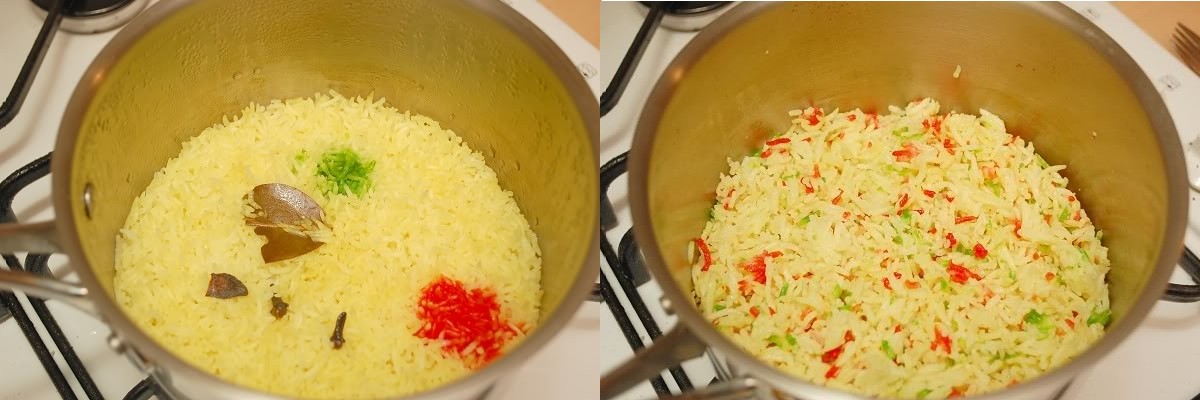Pulao Rice

Pulao1 rice is long-grain (usually Basmati) rice fried with spices and then cooked in stock or water served as an accompaniment to many Indian foods.
Pulao rice may be served at once but it is drier, and the grains separate better, if it is allowed to cool and then microwaved before serving.
The dish Pulao2 (or Pilaf) is related to the Biryani and consists of rice cooked with meat or seafood and/or vegetables.
INGREDIENTS
- Basmati rice (60-100 gm/person)
- Water or stock (twice as much as the rice)
- Aromat or salt to taste
- Oil or ghee
- Spices: bay, cloves, cinammon, nutmeg, star anis, cardamom
- Saffron (2-5 strands per person) or turmeric
- 1 drop each or one or more food colours
(each mixed, separately, in 1 Dsp water - optional)
PREPARATION
Total absorption cooking uses half as much dry rice as lightly salted water or stock by weight or volume (it's much the same). The pan must have a well-fitting lid and a thick bottom so that even on very low heat there is no “hot spot” where the rice can stick and burn.
Which spices you use, and how much of each, are a matter of personal choice - experiment. Traditionally Pulao is quite lightly spiced. If you use whole spices you should recover them after cooking as it's no fun to bite on a clove, cinammon stick or cardamom pod - I therefore use powdered spices here. Saffron or turmeric are not fried with the rest, and be very careful not to use too much turmeric as it can make the rice bitter. If you want a deep yellow use a little yellow food colouring in the liquid.
Rinse the rice thoroughly to remove loose starch, and drain it well. Heat the oil/ghee in the pan and fry the spices for a minute or two, add the rice and fry some more until all the grains are covered with spiced oil. Now add the boiling liquid and the saffron, turmeric or yellow colouring, stir well, bring back to the boil, fit the lid of the pan and cook on the
lowest possible heat that will keep the covered pan boiling for five minutes. Turn off the gas or remove from the electric ring and allow to stand for 6-8 minutes without stirring or removing the lid.
If you want ornamental coloured rice grains you should put a drop of food colour in a dessertspoonful of water, mix well and put on one part of the cooked rice, as shown in the picture. Repeat with additional colours if you wish. Allow to stand until cool and then remove any whole spices and stir to mix in the coloured rice grains. Store in a refrigerator and microwave before serving.

1 Pulao may also be known as pilaf, pilav, pilau, plov, polu and palaw.
2 Difference between Pulao and Biryani:- Both are mixed rice dishes popular in Indian cuisine. Although some of its varieties are associated with Persian influence in north India, Pulao is also mentioned in ancient Indian texts such as Yagnavalkya Smriti. Opinions differ on the differences between pulao and biryani, and whether there is a difference between the two at all. According to the author Abdul Halim Sharar, the biryani has a stronger taste of curried rice due to a higher amount of spices. Pratibha Karan states that while the terms are often applied arbitrarily, the main distinction is that a biryani comprises two layers of rice with a layer of meat (or vegetables) in the middle; the pulao is not layered. According to Holly Shaffer, based on her observations in Lucknow, in pulao, the rice and meat are cooked separately and then mixed before the dum cooking; in biryani, the soaked rice is fried and then cooked with the meat and stronger spices.
This is a recipe page on the James Bryant (G4CLF) Web-site.
Return to James Bryant's Recipe Index
Return to James Bryant's Home Page
Number of visits to this page:



